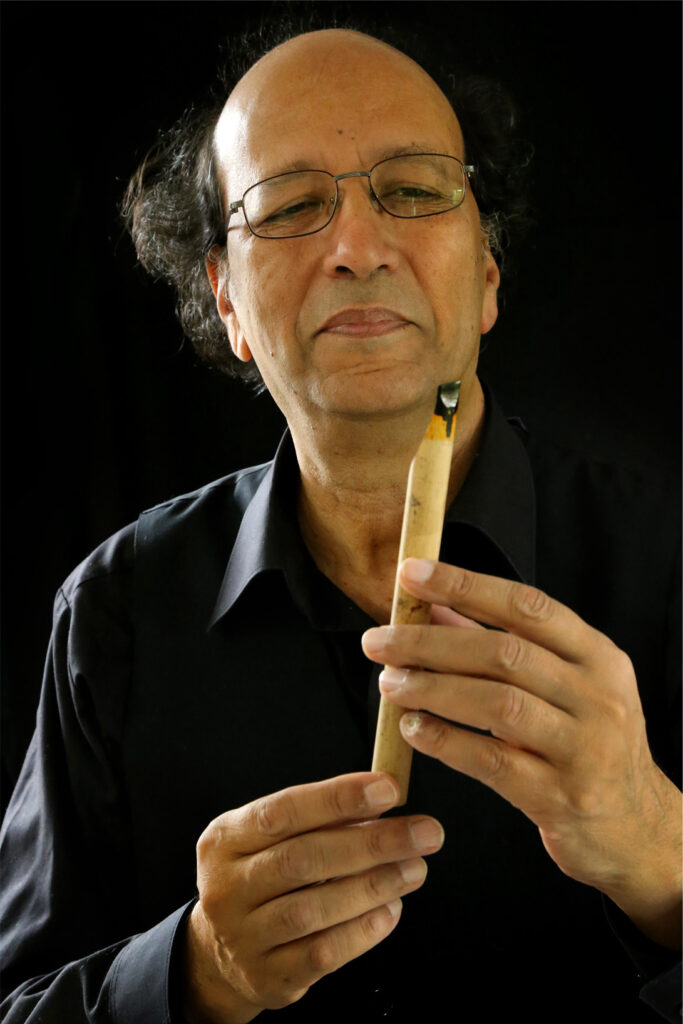An Introduction by Shahid Alam
In Baghdad, in what was called the House of Wisdom (Arabic: Bayt-al-Hikma), ninth-century translations of the most important works of the ancients were made from Greek to Arabic. Thus it became possible, later in Toledo, for the most significant scientific achievements of Hellenistic antiquity to be translated, in turn, from Arabic into Latin and then further rendered into individual vernaculars. Such a significant cultural transfer, accomplished by translators, would have been inconceivable without the advantages of Arabic literacy and of the special stylistic and conversational forms of the Arabic language.
The aesthetic of Arabic script stands at the center of the present exhibition. Now as then, the beauty of this form of writing can be the bridge permitting us to experience and to advance a mutual understanding. This bridge, whereby – as in Lessing’s philosophic drama Nathan the Wise – we come to recognize our own values in those of a different culture, leads to interreligious dialogue, to intercultural understanding in today’s Europe, and – not least – to a heightened awareness of Germany’s cultural diversity and a greater appreciation of its individual components.
The urgency of this undertaking is not self-evident but rather requires a cultural consciousness ever in need of renewal and of continual rethinking. Twelve centuries ago, Arabic script was the bridge to scientific development. Today, the present exhibition sets forth Arabic script as the aesthetic bridge to intercultural dialogue.
“God is beautiful and loves beauty,” we learn in a celebrated saying that is represented in the most beautiful way in many calligraphies. Or, as Friedrich Schiller declares, “’Tis through the eastern gate of Beauty / You to the land of knowledge come.” The aesthetic of Arabic script, the art of Islamic calligraphy, can open one’s heart to the beauty of God, can make accessible the bridge to knowledge, can advance and intensify intercultural understanding and interreligious dialogue. Since the summer of 2006 my work has been presented to the public in twenty exhibitions in Catholic and Protestant churches countrywide. To exhibit Islamic art and Arabic calligraphy in houses of Christian worship is not an idea that would have seemed obvious. By opening their doors to Islamic art these churches have taken a great and bold step forward. To look at the “other,” to recognize one’s own in what is offered by the other – precisely this feeling for the specialness of both self and other is what the translators achieved in the Bayt-al-Hikma, the House of Wisdom. Astonishment was aroused when Bishop Heinrich Mussinghoff opened the exhibition of 2007 in Aachen with a lecture on the first sura of the Qur’an, called “The Opening.” The overwhelming number of visitors at all my exhibitions has made clear the wide public appeal of such an undertaking.
Says Karl-Josef Kuschel in his book Life is Bridge-Building (2011): “In the light of the current world situation, the need for religious dialogue is more pressing than ever. History belongs to people who bring together what was isolated, who walk on paths that had been closed.”
The distinguishing aesthetic of Arabic script fascinated the great poet Goethe as it remains central to this exhibition. In a letter of 1815 Goethe wonderfully sums up what he so much admires: “In no language, perhaps, are God, world, and script as primally and inseparably embodied.”
What may be called the “center of gravity” in this exhibition, calligraphically rendered texts from Torah, Gospel, and Qur’an presented on large wooden panels (210 cm. by 75 cm.), can offer the viewer the opportunity for a thoughtful confrontation with the similarities and differences of content in the holy texts.
The bronze word-sculpture “’ILM” – meaning both “knowledge” and “wisdom” – opens a new approach to the calligraphic art. Here calligraphy becomes three-dimensional. The writing is freed from its two-dimensional background. It stands in free space. The blending of the letters, of the three root consonants (‘ain-lam-mim) and their transcendence of both triplicity and unity, will be visible from all sides.
The wooden sculpture “Alif,” three meters high, in a space where it is surrounded by other words, indicates what the alphabets in three holy scriptures have in common. The alphabet, in the three Mediterranean writing-cultures, begins with Arabic Alif, or Hebrew Aleph, or Greek Alpha. Accordingly, the Alif can be seen as central axis or midpoint of a triptych: at one side the first sura of the Qur’an (al-Fatiha) and at the other the Abana, the “Our Father,” as Arabic-speaking Christians are accustomed to say in prayer.
The calligraphically and imaginally presented poems of great poets and mystics such as Goethe, Rilke, Hölderlin, and Mansur Hallaj – in Arabic translation and also in the original script – form a further bridge for the viewer. The translations of Arabic poems into German and of the German poems into Arabic are literally bridges to other shores. Both the presentation of Arabic texts and their content are important for the comprehension of an art seeking to build a bridge between East and West and thus to come a bit nearer to the vision of Friedrich Rückert: “World poetry alone is world conciliation.”
Artist Shahid Alam, born in Lahore (Pakistan) in 1952, has lived since 1973 in Germany. He has studied pedagogy, art, politics, and European cultural history and was active for more than twenty years in the area of education and art. Since 1996 he has worked as an independent artist not far from Aachen


